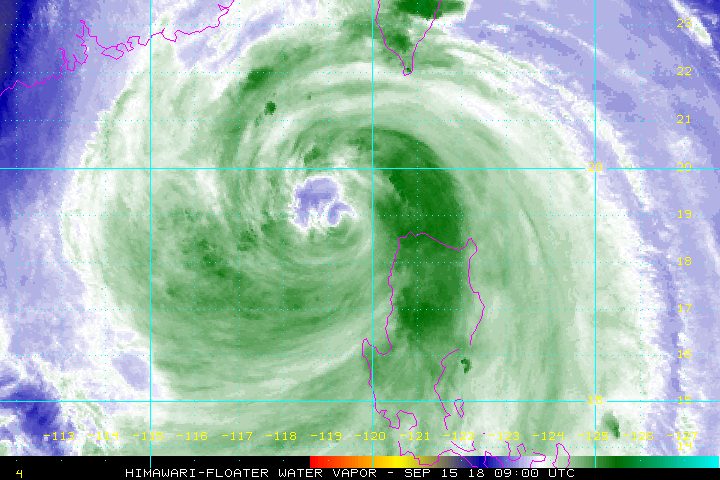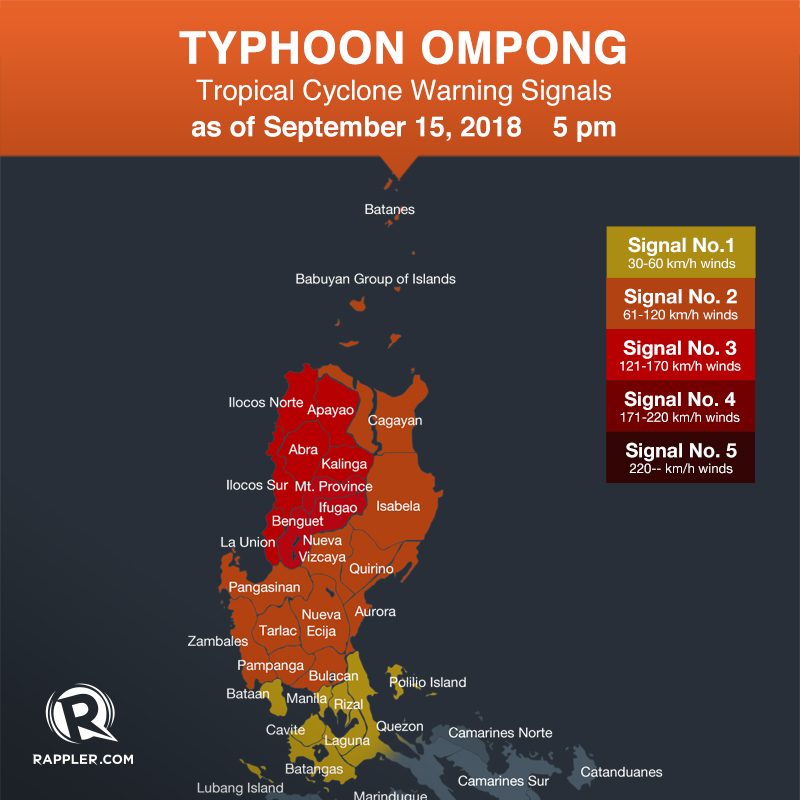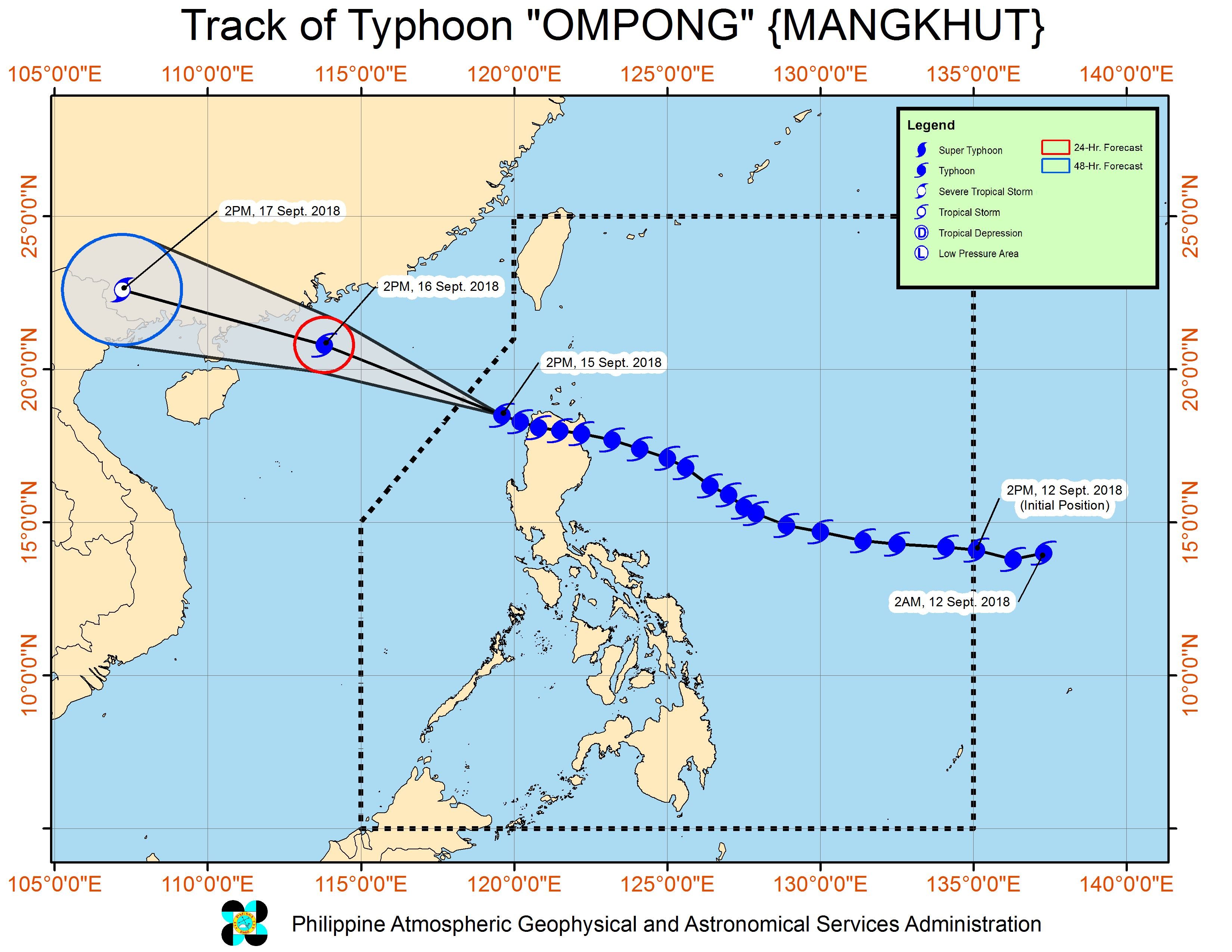SUMMARY
This is AI generated summarization, which may have errors. For context, always refer to the full article.

What’s the weather like in your area? Report the situation through Rappler’s Agos or tweet us at @rapplerdotcom.
MANILA, Philippines – Typhoon Ompong (Mangkhut) slightly weakened late Saturday afternoon, September 15, a few hours ahead of its expected exit from the Philippine Area of Responsibility (PAR). Its exit doesn’t mean, however, that there would no longer be any rain.
In a bulletin issued 5 pm on Saturday, the Philippine Atmospheric, Geophysical, and Astronomical Services Administration (PAGASA) said Ompong now has maximum winds of 160 kilometers per hour (km/h) from the previous 170 km/h and gustiness of up to 195 km/h from the previous 260 km/h.
The typhoon is already 160 kilometers west northwest of Laoag City, Ilocos Norte, still moving west northwest at 25 km/h. (READ: COMPARISON: Typhoon Ompong and previous Philippine typhoons)
Below are the areas remaining under tropical cyclone warning signals.
Signal No. 3:
- Ilocos Sur
- Ilocos Norte
- La Union
- Abra
- Apayao
- Kalinga
- Mountain Province
- Ifugao
- Benguet
Signal No. 2:
- Batanes
- Cagayan including Babuyan Group of Islands
- Isabela
- Nueva Vizcaya
- Quirino
- Pangasinan
- Zambales
- Tarlac
- Pampanga
- Bulacan
- Nueva Ecija
- Aurora
Signal No. 1:
- Metro Manila
- Bataan
- Rizal
- Cavite
- Batangas
- Laguna
- Lubang Island
- northern part of Quezon including Polillo Island

Based on its latest forecast track, Ompong might leave PAR between 8 pm and 10 pm on Saturday.
But PAGASA warned that due to the typhoon’s wide diameter, it will continue to bring rain and enhance the southwest monsoon or hanging habagat, even if it would be outside PAR already.
The enhanced southwest monsoon will trigger gusty winds and moderate to heavy rain in Western Visayas and Mimaropa. Scattered light to heavy rains will also hit Bicol, Eastern Visayas, and Central Visayas.
Residents of areas affected by the southwest monsoon should be on alert for flash floods and landslides, too. (READ: FAST FACTS: Tropical cyclones, rainfall advisories)

Fishermen and others with small sea vessels are advised not to venture out into the seaboards of areas under tropical cyclone warning signals, as well as the seaboards of Luzon and the Visayas.
More than 6,000 passengers have been stranded at various seaports. Domestic and international flights have been canceled. (READ: DFA giving P5,000 aid for OFWs stranded due to Typhoon Ompong)
Classes were also suspended in various regions. (READ: #WalangPasok: Class suspensions for September 13, 14, 15)
Ompong had made landfall in Baggao, Cagayan at 1:40 am on Saturday. The typhoon swept away the roof of the Cagayan provincial capitol and damaged the Tuguegarao Airport. (READ: 126,700 Filipinos affected hours after Ompong landfall)
So far, two responders and a child have been reported dead due to the typhoon.
The National Disaster Risk Reduction and Management Council earlier estimated that at least 5.2 million people were in Ompong’s path.
Thousands of people in affected areas were able to evacuate ahead of Ompong’s landfall. (READ: Will Typhoon Ompong be the same as Super Typhoon Lawin?)
National government agencies, local government units, the Armed Forces of the Philippines, the Philippine National Police, and the Philippine Coast Guard were placed on alert to respond to the typhoon. (READ: What gov’t has done so far to prepare for Typhoon Ompong)
Presidential Spokesperson Harry Roque said on Saturday that President Rodrigo Duterte is eyeing a trip to affected areas.
Ompong is the Philippines’ 15th tropical cyclone for 2018. The country usually gets an average of 20 tropical cyclones per year. (READ: LIST: PAGASA’s names for tropical cyclones in 2018)
PAGASA declared the start of the rainy season last June 8. – Rappler.com
News you can use during Typhoon Ompong (Mangkhut):
- Weather updates and storm signals
- Reports on evacuation, emergencies, and rescue and relief efforts
- Typhoon Ompong: Free parking at SM, Ayala, Robinsons, Megaworld malls
- #WalangPasok: Class suspensions for September 13, 14, 15
- Canceled flights due to Typhoon Ompong
- Will Typhoon Ompong be the same as Super Typhoon Lawin?
- COMPARISON: Typhoon Ompong and previous Philippine typhoons
- What gov’t has done so far to prepare for Typhoon Ompong
- Fact-check on viral stories related to Typhoon Ompong
- DFA giving P5,000 aid for OFWs stranded due to Typhoon Ompong
- 3 dams release water due to Typhoon Ompong
- Power lines affected by Typhoon Ompong
- Roads closed due to Typhoon Ompong
- Telco problems in Typhoon Ompong areas
- #ReliefPH: Help victims of Typhoon Ompong
Add a comment
How does this make you feel?
There are no comments yet. Add your comment to start the conversation.